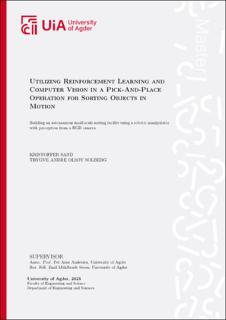| dc.description.abstract | This master's thesis studies the implementation of advanced machine learning (ML) techniques in industrial automation systems, focusing on applying machine learning to enable and evolve autonomous sorting capabilities in robotic manipulators. In particular, Inverse Kinematics (IK) and Reinforcement Learning (RL) are investigated as methods for controlling a UR10e robotic arm for pick-and-place of moving objects on a conveyor belt within a small-scale sorting facility. A camera-based computer vision system applying YOLOv8 is used for real-time object detection and instance segmentation. Perception data is utilized to ascertain optimal grip points, specifically through an implemented algorithm that outputs optimal grip position, angle, and width. As the implemented system includes testing and evaluation on a physical system, the intricacies of hardware control, specifically the reverse engineering of an OnRobot RG6 gripper is elaborated as part of this study.
The system is implemented on the Robotic Operating System (ROS), and its design is in particular driven by high modularity and scalability in mind. The camera-based vision system serves as the primary input, while the robot control is the output. The implemented system design allows for the evaluation of motion control employing both IK and RL. Computation of IK is conducted via MoveIt2, while the RL model is trained and computed in NVIDIA Isaac Sim.
The high-level control of the robotic manipulator was accomplished with use of Proximal Policy Optimization (PPO). The main result of the research is a novel reward function for the pick-and-place operation that takes into account distance and orientation from the target object. In addition, the provided system administers task control by independently initializing pick-and-place operation phases for each environment. The findings demonstrate that PPO was able to significantly enhance the velocity, accuracy, and adaptability of industrial automation. Our research shows that accurate control of the robot arm can be reached by training the PPO Model purely by applying a digital twin simulation. | |
